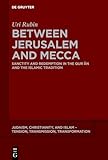Between Jerusalem and Mecca : Sanctity and Redemption in the Qurʾān and the Islamic Tradition / Uri Rubin (z"l).
Material type: TextSeries: Judaism, Christianity, and Islam – Tension, Transmission, Transformation ; 22Publisher: Berlin ; Boston : De Gruyter, [2023]Copyright date: ©2023Description: 1 online resource (XI, 246 p.)Content type:
TextSeries: Judaism, Christianity, and Islam – Tension, Transmission, Transformation ; 22Publisher: Berlin ; Boston : De Gruyter, [2023]Copyright date: ©2023Description: 1 online resource (XI, 246 p.)Content type: - 9783111220079
- 9783111222974
- 9783111222318
- 297.3/5569442 23//eng/20231012eng
- online - DeGruyter
- Issued also in print.
| Item type | Current library | Call number | URL | Status | Notes | Barcode | |
|---|---|---|---|---|---|---|---|
 eBook
eBook
|
Biblioteca "Angelicum" Pont. Univ. S.Tommaso d'Aquino Nuvola online | online - DeGruyter (Browse shelf(Opens below)) | Online access | Not for loan (Accesso limitato) | Accesso per gli utenti autorizzati / Access for authorized users | (dgr)9783111222318 |
Frontmatter -- Preface -- Contents -- Introduction -- Part One: Navel of the Earth -- 1 Muḥammad’s journey to the “Farthest Mosque” -- 2 Muḥammad’s ascension to heaven -- Part Two: Land of Redemption -- 3 Israel’s redemption and “the Promise of the Latter Days” -- Part Three: Land of Resurrection -- 4 Resurrection in al-Shām -- 5 Resurrection in Arabia -- Part Four: Land of the Prophets -- 6 The Patriarchs in al-Shām -- 7 Ishmael and the progeny of Abraham -- 8 Abraham and Ishmael build the Kaʿba -- 9 The attempted sacrifice between al-Shām and Mecca -- 10 The Kaʿba and the Prophets -- Part Five: Land of the Temple -- 11 Solomon’s Temple -- 12 “The first House established for the people” -- 13 The First House in Creation -- 14 The direction of prayer (qibla) within the sanctity space -- Part Six: The Messianic Vision Inverted -- 15 Romans (al-Rūm), Jews and Muslims -- Summary -- Bibliography -- Index
restricted access online access with authorization star
http://purl.org/coar/access_right/c_16ec
This book sheds new light on Jerusalem's status in early Islam. The sanctity of the city is already discerned in the Qurʾān. The vision of redemption that the Qurʾān displays coincides with the messianic expectations that have swept throughout the entire region, especially among the Jews, due to the attempted renewal of Jewish liturgy in Jerusalem following the Persian victory over Byzantium in 614.On the other hand, the Qurʾān also portrays the holiness of Mecca and the Kaʿba. This book shows how it promotes their pre-Islamic holiness around the image of Abraham and Ishmael. The changing balance between the sanctity of Jerusalem and the sanctity of Mecca, in favor of the latter, is noticeable in the Qurʾān as one proceeds from the Meccan sūras to the Medinan ones. The change occurs against the background of the twist in relations between Muḥammad and the Jews. This book also points out the correlation between Muḥammad's situation in Medina and events in Palestine involving the victory of the Byzantines over the Persians in 628, as alluded to in the opening passage of Sūrat al-Rūm (30).Thie work illuminates the growing sanctity of Jerusalem following the arrival of the first Muslims to Palestine. As in the Qurʾān, Mecca continued to struggle to preserve its status as a holy city vis-à-vis that of Jerusalem. Key aspects of this struggle are reflected in traditions in which patterns of sanctity move from Jerusalem to Mecca, and which this book also scrutinizes.
Issued also in print.
Mode of access: Internet via World Wide Web.
In English.
Description based on online resource; title from PDF title page (publisher's Web site, viewed 06. Mrz 2024)


